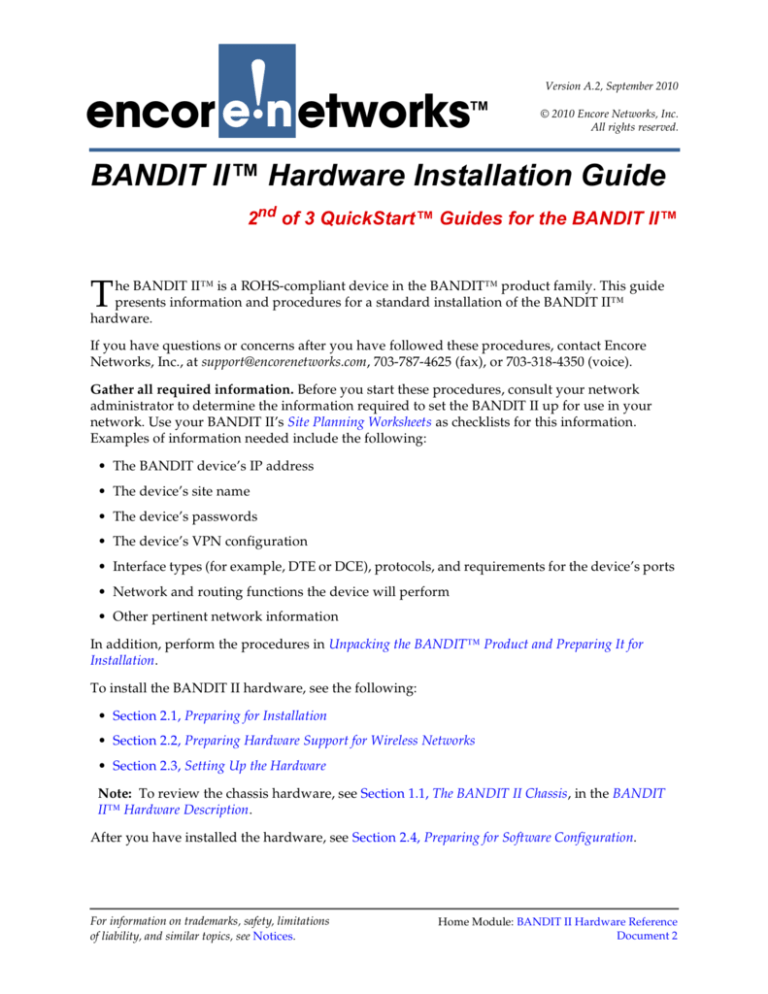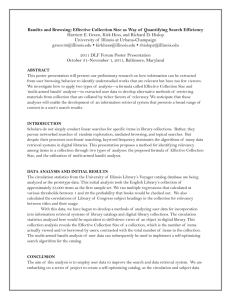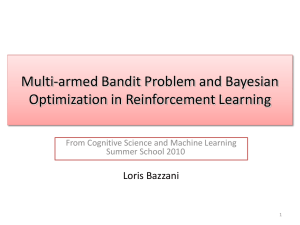
encor e!n etworks
•
TM
Version A.2, September 2010
© 2010 Encore Networks, Inc.
All rights reserved.
BANDIT II™ Hardware Installation Guide
2nd of 3 QuickStart™ Guides for the BANDIT II™
T
he BANDIT II™ is a ROHS-compliant device in the BANDIT™ product family. This guide
presents information and procedures for a standard installation of the BANDIT II™
hardware.
If you have questions or concerns after you have followed these procedures, contact Encore
Networks, Inc., at support@encorenetworks.com, 703-787-4625 (fax), or 703-318-4350 (voice).
Gather all required information. Before you start these procedures, consult your network
administrator to determine the information required to set the BANDIT II up for use in your
network. Use your BANDIT II’s Site Planning Worksheets as checklists for this information.
Examples of information needed include the following:
• The BANDIT device’s IP address
• The device’s site name
• The device’s passwords
• The device’s VPN configuration
• Interface types (for example, DTE or DCE), protocols, and requirements for the device’s ports
• Network and routing functions the device will perform
• Other pertinent network information
In addition, perform the procedures in Unpacking the BANDIT™ Product and Preparing It for
Installation.
To install the BANDIT II hardware, see the following:
• Section 2.1, Preparing for Installation
• Section 2.2, Preparing Hardware Support for Wireless Networks
• Section 2.3, Setting Up the Hardware
Note: To review the chassis hardware, see Section 1.1, The BANDIT II Chassis, in the BANDIT
II™ Hardware Description.
After you have installed the hardware, see Section 2.4, Preparing for Software Configuration.
For information on trademarks, safety, limitations
of liability, and similar topics, see Notices.
Home Module: BANDIT II Hardware Reference
Document 2
Page 2
2.1
BANDIT II Hardware Reference Module, Document 2
Preparing for Installation
The BANDIT II arrives ready to plug in and use. However, it is best to review details of
preparing the site, the chassis, and the cables. For this information, see the document
Unpacking the BANDIT™ Product and Preparing It for Installation.
At the least, do the following:
Unpack the chassis and components from the shipping box. Make sure you have all the
parts:
• A paper copy of this Installation Guide
• A CD of the BANDIT documentation
• A BANDIT II chassis
• An external AC power supply that accepts 100–240 VAC at 47–63 Hz input and
delivers 5 VDC at 3 amps output.
Note: Shipments of an AC BANDIT II chassis within North America include a power
cable for an AC outlet.
Shipments of an AC chassis outside North America do not include a power cable.
Contact your local or regional distributor for a cable that meets the specifications of the
country in which the BANDIT will be used. Use that cable to connect the BANDIT II’s
AC power supply to an AC power outlet.
• Any additional accessories that you ordered
Note: The connection between the BANDIT II and its management terminal (for example,
a PC) uses a straight-through DB9-to-DB9 cable. This cable is not included with the
BANDIT II; you must supply this cable.
2.2
Preparing Hardware Support for Wireless Networks
You select a CDMA or GSM internal wireless card when you order a BANDIT chassis.1
A GSM wireless card must hold the appropriate Subscriber Identity Module (SIM) for access
to the carrier’s GSM wireless network. Note the following:
• In a new BANDIT product, the proper SIM has already been installed in your BANDIT’s
GSM card. In this case, continue to Section 2.3, Setting Up the Hardware.
• If you change GSM carriers, you will need to install a SIM from the new carrier. In that
case, follow the instructions in Changing the SIM in a BANDIT™ Product’s GSM Card.
2.3
Setting Up the Hardware
Use the following procedure to connect cables to user equipment and prepare the BANDIT
II for configuration and use.
1. When you order a GSM card, you specify whether it uses GPRS or EDGE technology. A CDMA card
uses CDMA or EVDO CDMA technology.
BANDIT II™ Hardware Installation Guide
Page 3
Note: See the BANDIT II™ Hardware Description and the BANDIT II™ Hardware
Specifications for diagrams of pinouts.
Place the BANDIT II chassis on a tabletop or shelf.
1
Note: If you are placing the BANDIT II in a field utility shed, see Mounting the
BANDIT II™ on a Utility Wall.
Connect an earth ground wire to the chassis, as follows: Attach a (minimum) 12 AWG
wire to the earth ground bolt (next to the safety ground symbol), on the rear of the
chassis (recall Figure 1-3 through Figure 1-6 in Section 1.1, The BANDIT II Chassis, in the
BANDIT II™ Hardware Description). Use a ring terminal, such as an AMP (part
number 36160), for this connection.
2
Warning: An earth ground must connect to the chassis so that the chassis remains
grounded even when it is not receiving power.
Connect the BANDIT II’s ports to their network devices. For example, connect the LAN
port, WAN port, and serial port to the network devices, as follows:
3
Warning: If you need to disable the BANDIT’s plug-and-play mode, do not connect the
WAN port or the LAN port to equipment until after you have completed this entire
procedure.2
a Use an Ethernet 10-Base-T cable to connect the WAN port to the WAN equipment.
b Use an Ethernet 10-Base-T cable to connect the LAN port to its equipment.
c Connect additional network equipment to the serial port on the BANDIT device.
4
Use a DB9-to-DB9 cable to connect the BANDIT II’s DB9 Supervisory port to your
PC’s DB9 port.
5
Connect the AC power supply to the BANDIT II chassis, and then connect the AC
power supply to a power outlet supplying 100–240 VAC at 47–63 Hz.
❖ The BANDIT II chassis powers up.
The BANDIT II’s hardware installation is complete. Continue to Section 2.4, Preparing
for Software Configuration.
6
2.4
Preparing for Software Configuration
When you have finished installing the BANDIT II hardware, you are ready to configure the
software. Refer to your BANDIT II’s Site Planning Worksheets; then select one of the following:
• If the BANDIT II will be configured automatically over a Frame Relay network, see Using
FastCONNECT™.
• If the BANDIT II will be configured manually, via a direct connection to its Supervisory
port, refer to the following documents:
- Using the ELIOS™ Software
- Activating a Wireless Card in a Cellular Carrier Network
- BANDIT II™ and BANDIT III™ Quick Configuration Guide
2. Plug-and-play mode is disabled by default in all BANDIT chassis except the BANDIT IP.
Page 4
BANDIT II Hardware Reference Module, Document 2









